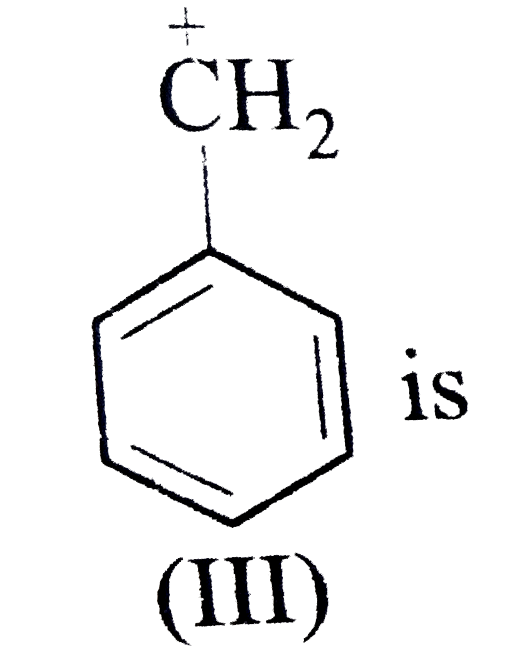What is the correct order of decreasing stability of the following cations
I. CH3−⊕CH−CH3 II. CH3−⊕CH−OCH3
III. CH3−⊕CH−CH2−OCH3
II>I>III
II>III>I
III>I>II
I>II>III
The correct Answer is:A
To determine the correct order of decreasing stability of the given cations, we need to analyze the structures and the effects of the substituents on the carbocations. Let's break down the solution step by step:
Step 1: Identify the Structures of the Cations
1. Cation I: CH₃−C⁺H−CH₃ (Secondary carbocation with two methyl groups)
2. Cation II: CH₃−C⁺H−OCH₃ (Secondary carbocation with one methyl and one methoxy group)
3. Cation III: CH₃−C⁺H−CH₂−OCH₃ (Secondary carbocation with one methyl and one methoxy group, but the methoxy is further away)
Step 2: Analyze the Electron-Donating Effects
- Cation I has two methyl groups. Methyl groups are electron-donating through the +I effect, which stabilizes the carbocation.
- Cation II has one methyl group and one methoxy group. The methoxy group can donate electrons through resonance (+R effect) and also has a +I effect, making this cation more stable than Cation I.
- Cation III has a methyl group and a methoxy group, but the methoxy group is further away from the positively charged carbon. The distance reduces its stabilizing effect. Additionally, the methoxy group can also act as an electron-withdrawing group due to the electronegativity of oxygen, which can destabilize the carbocation.
Step 3: Compare the Stability
- Cation II is the most stable due to the strong electron-donating effects from both the methyl and the methoxy groups.
- Cation I is next in stability because it has two methyl groups that provide stabilization.
- Cation III is the least stable because the methoxy group is further away, and its electron-withdrawing nature can destabilize the carbocation.
Final Order of Stability
The correct order of decreasing stability of the cations is:
Cation II > Cation I > Cation III
Conclusion
Thus, the final answer is:
Cation II > Cation I > Cation III
1. Cation I: CH₃−C⁺H−CH₃ (Secondary carbocation with two methyl groups)
2. Cation II: CH₃−C⁺H−OCH₃ (Secondary carbocation with one methyl and one methoxy group)
3. Cation III: CH₃−C⁺H−CH₂−OCH₃ (Secondary carbocation with one methyl and one methoxy group, but the methoxy is further away)
- Cation I has two methyl groups. Methyl groups are electron-donating through the +I effect, which stabilizes the carbocation.
- Cation II has one methyl group and one methoxy group. The methoxy group can donate electrons through resonance (+R effect) and also has a +I effect, making this cation more stable than Cation I.
- Cation III has a methyl group and a methoxy group, but the methoxy group is further away from the positively charged carbon. The distance reduces its stabilizing effect. Additionally, the methoxy group can also act as an electron-withdrawing group due to the electronegativity of oxygen, which can destabilize the carbocation.
- Cation II is the most stable due to the strong electron-donating effects from both the methyl and the methoxy groups.
- Cation I is next in stability because it has two methyl groups that provide stabilization.
- Cation III is the least stable because the methoxy group is further away, and its electron-withdrawing nature can destabilize the carbocation.
The correct order of decreasing stability of the cations is:
Cation II > Cation I > Cation III
Thus, the final answer is:
Cation II > Cation I > Cation III
Topper's Solved these Questions
- BOOK - NCERT EXEMPLARCHAPTER - ORGANIC CHEMISTRY : SOME BASIC PRINCIPLES AND TECHNIQUESEXERCISE - Short Answer type question27videos
ORGANIC CHEMISTRY : SOME BASIC PRINCIPLES AND TECHNIQUES
- BOOK - NCERT EXEMPLARCHAPTER - ORGANIC CHEMISTRY : SOME BASIC PRINCIPLES AND TECHNIQUESEXERCISE - Matching the columns5videos
ORGANIC CHEMISTRY : SOME BASIC PRINCIPLES AND TECHNIQUES
- BOOK - NCERT EXEMPLARCHAPTER - HYDROGENEXERCISE - LONG ANSWER TYPE QUESTIONS8videos
HYDROGEN
- BOOK - NCERT EXEMPLARCHAPTER - REDOX REACTIONSEXERCISE - LONG ANSWER TYPE QUESTIONS6videos
REDOX REACTIONS
Similar Questions
Knowledge Check
- Question 1 - Select One
What si the correct order of decreasing stability of the following carbocations.
CH3−⊕CH−CH3I. CH3−⊕CH−OCH3II.
CH3−⊕CH−CH2−OCH3III.AII>I>IIIBII>III>ICIII>I>IIDI>II>III - Question 2 - Select One
What is the correct order of decreasing stability of the following cations?
CH3−+CH−CH3I CH3−+CH−OCH3II
CH3−+CH−CH2−OCH3IIIAIIgtIgtIIIBIIgtIIIgtICIIIgtIgtIIDIgtIIgtIII - Question 3 - Select One
What si the correct order of decreasing stability of the following carbocations.
CH3−⊕CH−CH3I. CH3−⊕CH−OCH3II.
CH3−⊕CH−CH2−OCH3III.AII>I>IIIBII>III>ICIII>I>IIDI>II>III
The correct decreasing order of stability of I,II and III carbocations is:
(I) CH3−+CH−CH3 (II) CH3−+CH−COCH3
(III) CH3−+CH−OCH3View SolutionThe order of decreasing stability of the cations is :
(I) CH3+CHCH3 , (II) CH2+CHOCH3 , (III) CH3+CHCOCH3View SolutionGive the stability order of following radicals:
(I) CH3−⋅CH2
(II) CH3−⋅CH−CH3
(III) CH2=CH−⋅CH−CH3
(IV) View Solution
View SolutionThe order of decreasing stability of the following cations is :
CH3+C(I)HCH3,CH3+C(II)HOCH3,CH3+CHC(III)OCH3View SolutionThe order of stability of the following carbocations
CH2=+CH−CH2(I), CH3−CH2−+CH2(II)
 View Solution
View Solution

